Variability of Reproduction Pathways in the Central-European Populations of Hawthorns with Emphasis on Triploids
Abstract
1. Introduction
2. Materials and Methods
2.1. Plant Material
2.2. Evaluation of Reproduction Success through Seed Formation
2.3. Genome Size Quantification of Mature Plants
2.4. Flow Cytometric Seed Screen, Sample Preparations and Measurements
2.5. Flow Cytometric Seed Screen Data Analyses
3. Results
3.1. Evaluation of Seed Production in Diploids and Polyploids
3.2. Flow Cytometric Seed Screen of Diploid Mother Plants
3.3. Flow Cytometric Seed Screen of Polyploid Mother Plants
3.4. Reproduction Modes in Triploids
3.5. Reproduction Modes in Tetraploids
3.6. Difference in the Proportion of the Seed Categories among Triploids
4. Discussion
4.1. Reproduction Characteristics of a Diploid–Polyploid Plant System in Crataegus
- Sexual reproduction of diploids with reduced 1x embryo sac and double fertilization (both the egg and central cells) by reduced 1x sperm cells. Very rare fertilization by unreduced 2x pollen (or less probably reduced one originated from 3x or 4x plants) is also possible;
- Most of the polyploids (triploids and tetraploids) are almost obligate apomicts. An exception is represented by the rare case of almost sterile triploid C. kyrtostyla, the species which is commonly diploid. We suppose that this is probably a newly arisen triploid plant with the features of apomictic reproduction;
- Polyploid apomicts form almost exclusively unreduced embryo sac;
- Parthenogenesis is very common in the studied apomicts of Crataegus (>90%);
- Rare fertilization of meiotically unreduced egg cell in triploid apomicts is probably confined to certain genotypes and usually carried by a reduced 1x sperm cell;
- Triploids are capable of accepting the pollen with different ploidy levels, 1x, 2x, or even unbalanced ~1.5x, which is almost exclusively confined to fertilization of the central cell;
- Pseudogamy seems to be necessary for the seed formation in polyploid apomicts of Crataegus (confirmed in more than 99% of seeds);
- Tetraploids are able to produce rarely meiotically reduced embryo sac and sexual 4x embryos;
- Tetraploids are able to produce sporadically parthenogenetic diploid offspring.
4.2. Diploids Reproduce Sexually
4.3. Meiotically Unreduced Embryo Sac Characterizes Polyploids, and Rare Functional Meiosis Occurs More Frequently in Tetraploids than in Triploids
4.4. Rare Fertilization of Egg Cell and Almost Exclusive Fertilization of Central Cell Characterize Polyploids
4.5. Contrary to Tetraploids, Triploids Are Capable of Utilizing Various Pollen Cytotypes in the Double Fertilization of Central Cells
4.6. Variation in Endosperm Formation among Triploids Is Related to Pollen Self-/Cross-Compatibility and Inter-/Intracytotypic Compatibility
4.7. Evolutionary Implications of the Observed Variation in the Reproduction Pathways in Crataegus
5. Conclusions
Supplementary Materials
Author Contributions
Funding
Institutional Review Board Statement
Informed Consent Statement
Data Availability Statement
Acknowledgments
Conflicts of Interest
References
- Hörandl, E. A Combinational Theory for Maintenance of Sex. Heredity 2009, 103, 445–457. [Google Scholar] [CrossRef] [PubMed]
- Wood, T.E.; Takebayashi, N.; Barker, M.S.; Mayrose, I.; Greenspoon, P.B.; Rieseberg, L.H. The Frequency of Polyploid Speciation in Vascular Plants. Proc. Natl. Acad. Sci. USA 2009, 106, 13875–13879. [Google Scholar] [CrossRef] [PubMed]
- Arnold, M.L. Natural Hybridization as an Evolutionary Process. Annu. Rev. Ecol. Syst. 1992, 23, 237–261. [Google Scholar] [CrossRef]
- Hegarty, M.J.; Hiscock, S.J. Hybrid Speciation in Plants: New Insights from Molecular Studies. N. Phytol. 2005, 165, 411–423. [Google Scholar] [CrossRef]
- Soltis, P.S.; Soltis, D.E. The Role of Hybridization in Plant Speciation. Annu. Rev. Plant Biol. 2009, 60, 561–588. [Google Scholar] [CrossRef]
- Soltis, D.E.; Albert, V.A.; Leebens-Mack, J.; Bell, C.D.; Paterson, A.H.; Zheng, C.; Sankoff, D.; de Pamphilis, C.W.; Wall, P.K.; Soltis, P.S. Polyploidy and Angiosperm Diversification. Am. J. Bot. 2009, 96, 336–348. [Google Scholar] [CrossRef]
- Soltis, D.E.; Segovia-Salcedo, M.C.; Jordon-Thaden, I.; Majure, L.; Miles, N.M.; Mavrodiev, E.V.; Mei, W.; Cortez, M.B.; Soltis, P.S.; Gitzendanner, M.A. Are Polyploids Really Evolutionary Dead-Ends (Again)? A Critical Reappraisal of Mayrose et al. (2011). N. Phytol. 2014, 202, 1105–1117. [Google Scholar] [CrossRef]
- Kearney, M. Hybridization, Glaciation and Geographical Parthenogenesis. Trends Ecol. Evol. 2005, 20, 495–502. [Google Scholar] [CrossRef]
- Hörandl, E. Geographical Parthenogenesis: Opportunities for Asexuality. In Lost Sex, the Evolutionary Biology of Parthenogenesis; Schön, I., Martens, K., Van Dijk, P., Eds.; Springer: Berlin/Heidelberg, Germany, 2009; pp. 161–186. [Google Scholar]
- Hojsgaard, D.; Greilhuber, J.; Pellino, M.; Paun, O.; Sharbel, T.F.; Hörandl, E. Emergence of Apospory and Bypass of Meiosis via Apomixis after Sexual Hybridisation and Polyploidisation. N. Phytol. 2014, 204, 1000–1012. [Google Scholar] [CrossRef]
- Barrett, S.C.H. Major Evolutionary Transitions in Flowering Plant Reproduction: An Overview. Int. J. Plant Sci. 2008, 169, 1–5. [Google Scholar] [CrossRef]
- Hörandl, E. The Complex Causality of Geographical Parthenogenesis. N. Phytol. 2006, 171, 525–538. [Google Scholar] [CrossRef] [PubMed]
- Paun, O.; Stuessy, T.F.; Hörandl, E. The Role of Hybridization, Polyploidization and Glaciation in the Origin and Evolution of the Apomictic Ranunculus cassubicus Complex. N. Phytol. 2006, 171, 223–236. [Google Scholar] [CrossRef] [PubMed]
- Weijers, D. Note from Editor-in-Chief. Plant Reprod. 2013, 26, 63. [Google Scholar] [CrossRef] [PubMed][Green Version]
- Holsinger, K.E. Reproductive Systems and Evolution in Vascular Plants. Proc. Natl. Acad. Sci. USA 2000, 97, 7037–7042. [Google Scholar] [CrossRef]
- Ronsheim, M.L.; Bever, J.D. Genetic Variation and Evolutionary Trade-Offs for Sexual and Asexual Reproductive Modes in Allium vineale (Liliaceae). Am. J. Bot. 2000, 87, 1769–1777. [Google Scholar] [CrossRef]
- Verduijn, M.H.; van Dijk, P.J.; van Damme, J.M.M. The Role of Tetraploids in the Sexual–Asexual Cycle in Dandelions (Taraxacum). Heredity 2004, 93, 390–398. [Google Scholar] [CrossRef]
- Silvertown, J. The Evolutionary Maintenance of Sexual Reproduction: Evidence from the Ecological Distribution of Asexual Reproduction in Clonal Plants. Int. J. Plant Sci. 2008, 169, 157–168. [Google Scholar] [CrossRef]
- Hörandl, E.; Hojsgaard, D. The Evolution of Apomixis in Angiosperms: A Reappraisal. Plant Biosyst. 2012, 146, 681–693. [Google Scholar] [CrossRef]
- Voigt-Zielinski, M.-L.; Piwczyński, M.; Sharbel, T.F. Differential Effects of Polyploidy and Diploidy on Fitness of Apomictic Boechera. Sex. Plant Reprod. 2012, 25, 97–109. [Google Scholar] [CrossRef]
- Hojsgaard, D.; Hörandl, E. A Little Bit of Sex Matters for Genome Evolution in Asexual Plants. Front. Plant Sci. 2015, 6, 82. [Google Scholar] [CrossRef]
- Kolarčik, V.; Kocová, V.; Vašková, D. Flow Cytometric Seed Screen Data Are Consistent with Models of Chromosome Inheritance in Asymmetrically Compensating Allopolyploids. Cytom. Part A 2018, 93, 737–748. [Google Scholar] [CrossRef] [PubMed]
- Karbstein, K.; Tomasello, S.; Hodač, L.; Wagner, N.; Marinček, P.; Barke, B.; Paetzold, C.; Hörandl, E. Untying Gordian Knots: Unraveling Reticulate Polyploid Plant Evolution by Genomic Data Using the Large Ranunculus auricomus Species Complex. N. Phytol. 2022, 235, 2081–2098. [Google Scholar] [CrossRef] [PubMed]
- Aliyu, O.M.; Schranz, M.E.; Sharbel, T.F. Quantitative Variation for Apomictic Reproduction in the Genus Boechera (Brassicaceae). Am. J. Bot. 2010, 97, 1719–1731. [Google Scholar] [CrossRef] [PubMed]
- Krahulcová, A.; Rotreklová, O. Use of Flow Cytometry in Research on Apomictic Plants. Preslia 2010, 82, 23–39. [Google Scholar]
- Kalkman, C. Rosaceae. In The Families and Genera of Vascular Plants; Kubitzki, K., Ed.; Springer: Berlin/Heidelberg, Germany, 2004; pp. 343–386. [Google Scholar]
- Campbell, C.S.; Evans, R.C.; Morgan, D.R.; Dickinson, T.A.; Arsenault, M.P. Phylogeny of Subtribe Pyrinae (Formerly the Maloideae, Rosaceae): Limited Resolution of a Complex Evolutionary History. Plant Syst. Evol. 2007, 266, 119–145. [Google Scholar] [CrossRef]
- Potter, D.; Eriksson, T.; Evans, R.; Oh, S.-H.; Smedmark, J.; Morgan, D.; Kerr, M.; Robertson, K.R.; Arsenault, M.; Dickinson, T.A.; et al. Phylogeny and Classification of Rosaceae. Plant Syst. Evol. 2007, 266, 5–43. [Google Scholar] [CrossRef]
- Sun, J.; Shi, S.; Li, J.; Yu, J.; Wang, L.; Yang, X.; Guo, L.; Zhou, S. Phylogeny of Maleae (Rosaceae) Based on Multiple Chloroplast Regions: Implications to Genera Circumscription. BioMed Res. Int. 2018, 2018, 7627191. [Google Scholar] [CrossRef]
- Turland, N.J.; Wiersema, J.H.; Barrie, F.R.; Greuter, W.; Hawksworth, D.L.; Herendeen, P.S.; Knapp, S.; Kusber, W.-H.; Li, D.-Z.; Marhold, K.; et al. International Code of Nomenclature for Algae, Fungi, and Plants (Shenzhen Code) Adopted by the Nineteenth International Botanical Congress Shenzhen, China, July 2017; Regnum Vegetabile 159; Koeltz Botanical Books: Glashütten, Germany, 2018. [Google Scholar]
- Burgess, M.B.; Cushman, K.R.; Doucette, E.T.; Talent, N.; Frye, C.T.; Campbell, C.S. Effects of Apomixis and Polyploidy on Diversification and Geographic Distribution in Amelanchier (Rosaceae). Am. J. Bot. 2014, 101, 1375–1387. [Google Scholar] [CrossRef]
- Macková, L.; Nosková, J.; Ďurišová, Ľ.; Urfus, T. Insights into the Cytotype and Reproductive Puzzle of Cotoneaster integerrimus in the Western Carpathians. Plant Syst. Evol. 2020, 306, 58. [Google Scholar] [CrossRef]
- Bogunić, F.; Siljak-Yakovlev, S.; Mahmutović-Dizdarević, I.; Hajrudinović-Bogunić, A.; Bourge, M.; Brown, S.C.; Muratović, E. Genome Size, Cytotype Diversity and Reproductive Mode Variation of Cotoneaster integerrimus (Rosaceae) from the Balkans. Plants 2021, 10, 2798. [Google Scholar] [CrossRef]
- Lepší, M.; Koutecký, P.; Nosková, J.; Lepší, P.; Urfus, T.; Rich, T.C.G. Versatility of Reproductive Modes and Ploidy Level Interactions in Sorbus s.l. (Malinae, Rosaceae). Bot. J. Linn. Soc. 2019, 191, 502–522. [Google Scholar] [CrossRef]
- Christensen, K.I. Revision of Crataegus Sect. Crataegus and Nothosect. Crataeguineae (Rosaceae-Maloideae) in the Old World. Syst. Bot. Monogr. 1992, 35, 1–199. [Google Scholar] [CrossRef]
- Phipps, J.B.; O’Kennon, R.J.; Lance, R.W. Hawthorns and Medlars; Timber Press: Portland, OR, USA, 2003; pp. 1–139. [Google Scholar]
- Amaral Franco, J. 34. Crataegus L. In Flora Europea, Vol. 2. Rosaceae to Umbelifereae.; Tutin, T.G., Heywood, W.H., Burges, N.A., Moore, D.M., Valentine, D.H., Walters, S.M., Webb, D.A., Eds.; Cambridge University Press: Cambridge, UK, 1968; pp. 73–77. [Google Scholar]
- Gosler, A. Introgressive Hybridization between Crataegus monogyna Jacq. and C. laevigata (Poiret) DC. in the Upper Thames Valley, England. Watsonia 1990, 18, 49–62. [Google Scholar]
- Talent, N.; Dickinson, T.A. Polyploidy in Crataegus and Mespilus (Rosaceae, Maloideae): Evolutionary Inferences from Flow Cytometry of Nuclear DNA Amounts. Can. J. Bot. 2005, 83, 1268–1304. [Google Scholar] [CrossRef]
- Talent, N.; Dickinson, T.A. Endosperm Formation in Aposporous Crataegus (Rosaceae, Spiraeoideae, Tribe Pyreae): Parallels to Ranunculaceae and Poaceae. N. Phytol. 2007, 173, 231–249. [Google Scholar] [CrossRef]
- Lo, E.; Stefanović, S.; Dickinson, T.A. Reconstructing Reticulation History in a Phylogenetic Framework and the Potential of Allopatric Speciation Driven by Polyploidy in an Agamic Complex in Crataegus (Rosaceae). Evolution 2010, 64, 3593–3608. [Google Scholar] [CrossRef]
- Lo, E.Y.Y.; Donoghue, M.J. Expanded Phylogenetic and Dating Analyses of the Apples and Their Relatives (Pyreae, Rosaceae). Mol. Phylogenet. Evol. 2012, 63, 230–243. [Google Scholar] [CrossRef]
- Zarrei, M.; Stefanović, S.; Dickinson, T.A. Reticulate Evolution in North American Black-Fruited Hawthorns (Crataegus Section Douglasia; Rosaceae): Evidence from Nuclear ITS2 and Plastid Sequences. Ann. Bot. 2014, 114, 253–269. [Google Scholar] [CrossRef]
- Liston, A.; Weitemier, K.A.; Letelier, L.; Podani, J.; Zong, Y.; Liu, L.; Dickinson, T.A. Phylogeny of Crataegus (Rosaceae) Based on 257 Nuclear Loci and Chloroplast Genomes: Evaluating the Impact of Hybridization. PeerJ 2021, 9, e12418. [Google Scholar] [CrossRef]
- Ptak, K. Cyto-Embryological Investigations on the Polish Representatives of the Genus Crataegus L. I. Chromosome Numbers; Embryology of Diploid and Tetraploid Species. Acta Biol. Crac. Ser. Bot. 1986, 28, 107–122. [Google Scholar]
- Ptak, K. Cyto-Embryological Investigations on the Polish Representatives of the Genus Crataegus L. II. Embryology of Triploid Species. Acta Biol. Crac. Ser. Bot. 1989, 31, 97–113. [Google Scholar]
- Vašková, D.; Kolarčik, V. Breeding Systems in Diploid and Polyploid Hawthorns (Crataegus): Evidence from Experimental Pollinations of C. monogyna, C. subsphaerica, and Natural Hybrids. Forests 2019, 10, 1059. [Google Scholar] [CrossRef]
- Depypere, L.; vander Mijnsbrugge, K.; de Cock, K.; Verschelde, P.; Quataert, P.; van Slycken, J.; Goetghebeur, P. Indigenous Species of Crataegus (Rosaceae-Maloideae) in Flanders (Belgium). An Explorative Morphometric Study. Belgian J. Bot. 2006, 139, 139–152. [Google Scholar] [CrossRef]
- Oklejewicz, K.; Chwastek, E.; Szewczyk, M.; Bobiec, A.; Mitka, J. Distribution of Crataegus (Rosaceae) in S-E Poland along a Gradient of Anthropogenic Influence. Polish J. Ecol. 2013, 61, 683–691. [Google Scholar]
- Jones, A.T.; Hayes, M.J.; Sackville Hamilton, N.R. The Effect of Provenance on the Performance of Crataegus monogyna in Hedges. J. Appl. Ecol. 2002, 38, 952–962. [Google Scholar] [CrossRef]
- Kuhn, T.; Györfi, O.; Ruprecht, E. Seedling Performance, Allocation Patterns and Phenotypic Plasticity of Two Sympatric Hawthorn Species and Their Natural Hybrid. Flora 2022, 287, 151994. [Google Scholar] [CrossRef]
- Vander Mijnsbrugge, K.; Onkelinx, T.; De Cuyper, B. Variation in Bud Burst and Flower Opening Responses of Local versus Non-Local Provenances of Hawthorn (Crataegus monogyna Jacq.) in Belgium. Plant Syst. Evol. 2015, 301, 1171–1179. [Google Scholar] [CrossRef]
- Wrońska-Pilarek, D.; Bocianowski, J.; Jagodziński, A.M. Comparison of Pollen Grain Morphological Features of Selected Species of the Genus Crataegus (Rosaceae) and Their Spontaneous Hybrids. Bot. J. Linn. Soc. 2013, 172, 555–571. [Google Scholar] [CrossRef]
- Fineschi, S.; Salvini, D.; Turchini, D.; Pastorelli, R.; Vendramin, G.G. Crataegus monogyna Jacq. and C. laevigata (Poir.) DC. (Rosaceae, Maloideae) Display Low Level of Genetic Diversity Assessed by Chloroplast Markers. Plant Syst. Evol. 2005, 250, 187–196. [Google Scholar] [CrossRef]
- Ferrazzini, D.; Monteleone, I.; Belletti, P. Small-Scale Genetic Diversity in Oneseed Hawthorn (Crataegus monogyna Jacq.). Eur. J. For. Res. 2008, 127, 407–414. [Google Scholar] [CrossRef]
- Brown, J.A.; Beatty, G.E.; Finlay, C.M.V.; Montgomery, W.I.; Tosh, D.G.; Provan, J. Genetic Analyses Reveal High Levels of Seed and Pollen Flow in Hawthorn (Crataegus monogyna Jacq.), a Key Component of Hedgerows. Tree Genet. Genomes 2016, 12, 58. [Google Scholar] [CrossRef]
- Urbonavičiūtė, A.; Jakštas, V.; Kornyšova, O.; Janulis, V.; Maruška, A. Capillary Electrophoretic Analysis of Flavonoids in Single-Styled Hawthorn (Crataegus monogyna Jacq.) Ethanolic Extracts. J. Chromatogr. A 2006, 1112, 339–344. [Google Scholar] [CrossRef] [PubMed]
- Dursun, A.; Çalışkan, O.; Guler, Z.; Bayazıt, S.; Türkmen, D.; Gunduz, K. Effect of Harvest Maturity on Volatile Compounds Profiling and Eating Quality of Hawthorn (Crataegus azarolus L.) Fruit. Sci. Hortic. 2021, 288, 110398. [Google Scholar] [CrossRef]
- Belabdelli, F.; Bekhti, N.; Piras, A.; Benhafsa, F.M.; Ilham, M.; Adil, S.; Anes, L. Chemical Composition, Antioxidant and Antibacterial Activity Of Crataegus monogyna Leaves’ Extracts. Nat. Prod. Res. 2021, 36, 3234–3239. [Google Scholar] [CrossRef]
- Lo, E.Y.Y.; Stefanović, S.; Dickinson, T.A. Geographical Parthenogenesis in Pacific Northwest Hawthorns (Crataegus; Rosaceae). Botany 2013, 91, 107–116. [Google Scholar] [CrossRef]
- Comai, L. The Advantages and Disadvantages of Being Polyploid. Nat. Rev. Genet. 2005, 6, 836–846. [Google Scholar] [CrossRef]
- Talent, N.; Dickinson, T.A. The Potential for Ploidy Level Increases and Decreases in Crataegus (Rosaceae, Spiraeoideae, Tribe Pyreae). Can. J. Bot. 2007, 85, 570–584. [Google Scholar] [CrossRef][Green Version]
- Pellino, M.; Hojsgaard, D.; Schmutzer, T.; Scholz, U.; Hörandl, E.; Vogel, H.; Sharbel, T. Asexual Genome Evolution in the Apomictic Ranunculus auricomus Complex: Examining the Effects of Hybridization and Mutation Accumulation. Mol. Ecol. 2013, 22, 5908–5921. [Google Scholar] [CrossRef]
- Muniyamma, M.; Phipps, J.B. Studies in Crataegus. X. A Note on the Occurrence of Diplospory in Crataegus dissona Sarg. (Maloideae, Rosaceae). Can. J. Genet. Cytol. 1984, 26, 249–252. [Google Scholar] [CrossRef]
- Muniyamma, M.; Phipps, J.B. Studies in Crataegus. XII. Cytological Evidence for Sexuality in Some Diploid and Tetraploid Species of North American Hawthorns. Can. J. Bot. 1985, 63, 1319–1324. [Google Scholar] [CrossRef]
- Talent, N. Evolution of Gametophytic Apomixis in Flowering Plants: An Alternative Model from Maloid Rosaceae. Theory Biosci. 2009, 128, 121–138. [Google Scholar] [CrossRef] [PubMed]
- Camp, W.H. Ecological Problems and Species Concepts in Crataegus. Ecology 1942, 23, 368–369. [Google Scholar] [CrossRef]
- Hamston, T.J.; Wilson, R.J.; de Vere, N.; Rich, T.C.G.; Stevens, J.R.; Cresswell, J.E. Breeding System and Spatial Isolation from Congeners Strongly Constrain Seed Set in an Insect-Pollinated Apomictic Tree: Sorbus subcuneata (Rosaceae). Sci. Rep. 2017, 7, 45122. [Google Scholar] [CrossRef] [PubMed]
- Ludwig, S.; Robertson, A.; Rich, T.; Đorđević, M.; Cerović, R.; Houston, L.; Harris, S.; Hiscock, S. Breeding Systems, Hybridization and Continuing Evolution in Avon Gorge Sorbus. Ann. Bot. 2013, 111, 563–575. [Google Scholar] [CrossRef] [PubMed]
- Suda, J.; Kron, P.; Husband, B.C.; Trávníček, P. Flow Cytometry and Ploidy: Applications in Plant Systematics, Ecology and Evolutionary Biology. In Flow Cytometry with Plant Cells; Doležel, J., Greilhuber, J., Suda, J., Eds.; Wiley-VCH Verlag GmbH & Co. KGaA: Weinheim, Germany, 2007; pp. 103–130. [Google Scholar]
- Matzk, F.; Meister, A.; Schubert, I. An Efficient Screen for Reproductive Pathways Using Mature Seeds of Monocots and Dicots. Plant J. 2000, 21, 97–108. [Google Scholar] [CrossRef]
- Aldasoro, J.J.; Aedo, C.; Navarro, C. Phylogenetic and Phytogeographical Relationships in Maloideae (Rosaceae) Based on Morphological and Anatomical Characters. Blumea-Biodivers. Evol. Biogeogr. Plants 2005, 50, 3–32. [Google Scholar] [CrossRef]
- Šarhanová, P.; Vašut, R.; Dančák, M.; Bureš, P.; Trávníček, B. New Insights into the Variability of Reproduction Modes in European Populations of Rubus Subgen. Rubus: How Sexual Are Polyploid Brambles? Sex. Plant Reprod. 2012, 25, 319–335. [Google Scholar] [CrossRef]
- Dobeš, C.; Lückl, A.; Hülber, K.; Paule, J. Prospects and Limits of the Flow Cytometric Seed Screen–Insights from Potentilla Sensu Lato (Potentilleae, Rosaceae). N. Phytol. 2013, 198, 605–616. [Google Scholar] [CrossRef]
- Dobeš, C.; Milosevic, A.; Prohaska, D.; Scheffknecht, S.; Sharbel, T.; Hülber, K. Reproductive Differentiation into Sexual and Apomictic Polyploid Races in Potentilla puberula (Potentilleae, Rosaceae). Ann. Bot. 2013, 112, 1159–1168. [Google Scholar] [CrossRef]
- Hajrudinović, A.; Siljak-Yakovlev, S.; Brown, S.C.; Pustahija, F.; Bourge, M.; Ballian, D.; Bogunić, F. When Sexual Meets Apomict: Genome Size, Ploidy Level and Reproductive Mode Variation of Sorbus aria s.l. and S. austriaca (Rosaceae) in Bosnia and Herzegovina. Ann. Bot. 2015, 116, 301–312. [Google Scholar] [CrossRef]
- Holub, J. 10. Crataegus L.-Hloh. In Květena České Republiky 3; Hejný, S., Slavík, B., Eds.; Academia: Praha, Czech Republic, 1992; pp. 488–525. [Google Scholar]
- Kolarčik, V.; (Pavol Jozef Šafárik University, Košice, Slovakia); Mikoláš, V.; (independent researcher, Košice, Slovakia); Vargovčíková, J.; (independent researcher, Veľké Kapušany, Slovakia). Flow Cytometry Screening of Ploidy Level in Mixed-Cytotype Populations of Crataegus (Rosaceae) in Eastern Slovakia (Central Europe). 2022; manuscript in preparation. [Google Scholar]
- Doležel, J.; Greilhuber, J.; Lucretti, S.; Meister, A.; Lysák, M.A.; Nardi, L.; Obermayer, R. Plant Genome Size Estimation by Flow Cytometry: Inter-Laboratory Comparison. Ann. Bot. 1998, 82, 17–26. [Google Scholar] [CrossRef]
- Temsch, E.M.; Greilhuber, J.; Krisai, R. Genome Size in Liverworts. Preslia 2010, 82, 63–80. [Google Scholar]
- Loureiro, J.; Rodriguez, E.; Doležel, J.; Santos, C. Two New Nuclear Isolation Buffers for Plant DNA Flow Cytometry: A Test with 37 Species. Ann. Bot. 2007, 100, 875–888. [Google Scholar] [CrossRef] [PubMed]
- Doležel, J.; Bartoš, J. Plant DNA Fow Cytometry and Estimation of Nuclear Genome Size. Ann. Bot. 2005, 95, 99–110. [Google Scholar] [CrossRef] [PubMed]
- Kao, R.H. Asexuality and Coexistance of Cytotypes. N. Phytol. 2007, 175, 764–772. [Google Scholar] [CrossRef]
- Matzk, F.; Meister, A.; Brutovská, R.; Schubert, I. Reconstruction of Reproductive Diversity in Hypericum perforatum L. Opens Novel Strategies to Manage Apomixis. Plant J. 2001, 26, 275–282. [Google Scholar] [CrossRef]
- R Core Team. R: A Language and Environment for Statistical Computing; R Foundation for Statistical Computing: Vienna, Austria, 2019. [Google Scholar]
- Oksanen, J.; Blanchet, F.G.; Friendly, M.; Kindt, R.; Legendre, P.; McGlinn, D.; Minchin, P.R.; O’Hara, R.B.; Simpson, G.L.; Solymos, P.; et al. Vegan: Community Ecology Package. R Package Version 2.5-4. 2019. Available online: https://CRAN.R-project.org/package=vegan (accessed on 4 April 2019).
- Wei, T.; Simko, V. R Package “Corrplot”: Visualization of a Correlation Matrix. R Package Version 0.92. 2021. Available online: https://CRAN.R-project.org/package=corrplot (accessed on 30 June 2022).
- van Baarlen, P.; van Dijk, P.J.; Hoekstra, R.F.; de Jong, J.H. Meiotic Recombination in Sexual Diploid and Apomictic Triploid Dandelions (Taraxacum officinale L.). Genome 2000, 43, 827–835. [Google Scholar] [CrossRef]
- Martínez, E.J.; Acuña, C.A.; Hojsgaard, D.H.; Tcach, M.A.; Quarin, C.L. Segregation for Sexual Seed Production in Paspalum as Directed by Male Gametes of Apomictic Triploid Plants. Ann. Bot. 2007, 100, 1239–1247. [Google Scholar] [CrossRef]
- Delgado, L.; Galdeano, F.; Sartor, M.E.; Quarin, C.L.; Espinoza, F.; Ortiz, J.P.A. Analysis of Variation for Apomictic Reproduction in Diploid Paspalum rufum. Ann. Bot. 2014, 113, 1211–1218. [Google Scholar] [CrossRef]
- Böcher, T. Cytological and Embryological Studies in the Amphi-Apomictic Arabis holboellii Complex. Biol. Skr. 1951, 6, 1–58. [Google Scholar]
- Böcher, T. Experimental Taxonomical Studies in the Arabis holboellii Complex. Sven. Bot. Tidskr. 1954, 48, 31–44. [Google Scholar]
- Sharbel, T.F.; Mitchell-Olds, T. Recurrent Polyploid Origins and Chloroplast Phylogeography in the Arabis holboellii Complex (Brassicaceae). Heredity 2001, 87, 59–68. [Google Scholar] [CrossRef] [PubMed]
- Sochor, M.; Trávníček, B. Melting Pot of Biodiversity: First Insights into the Evolutionary Patterns of the Colchic Bramble Flora (Rubus Subgenus Rubus, Rosaceae). Bot. J. Linn. Soc. 2016, 181, 610–620. [Google Scholar] [CrossRef]
- Dickinson, T.A.; Phipps, J. Studies in Crataegus (Rosaceae: Maloideae) XIV. The Breeding System of Crataegus crus-galli Sensu Lato in Ontario. Am. J. Bot. 1986, 73, 116–130. [Google Scholar] [CrossRef] [PubMed]
- Smith, P.G.; Phipps, J.B. Studies in Crataegus (Rosaceae, Maloideae). XIX. Breeding Behavior in Ontario Crataegus Series Rotundifoliae. Can. J. Bot. 1988, 66, 1914–1923. [Google Scholar] [CrossRef]
- Leblanc, O.; Mazzucato, A. Screening Procedures to Identify and Quantify Apomixis. In The Flowering of Apomixis: From Mechanisms to Genetic Engineering; Savidan, Y., Carman, J.G., Dresselhaus, T., Eds.; ClMMYT, IRD, European Commission DG VI (FAIR): Mexico, Mexico, 2001; pp. 121–136. [Google Scholar]
- Lin, B.Y. Ploidy Barrier to Endosperm Development in Maize. Genetics 1984, 107, 103–115. [Google Scholar] [CrossRef]
- Dilkes, B.; Comai, L. A Differential Dosage Hypothesis for Parental Effects in Seed Development. Plant Cell 2005, 16, 3174–3180. [Google Scholar] [CrossRef]
- Köhler, C.; Mittelsten Scheid, O.; Erilova, A. The Impact of the Triploid Block on the Origin and Evolution of Polyploid Plants. Trends Genet. 2010, 26, 142–148. [Google Scholar] [CrossRef]
- Scott, R.J.; Spielman, M.; Bailey, J.; Dickinson, H.G. Parent-of-Origin Effects on Seed Development in Arabidopsis thaliana. Development 1998, 125, 3329–3341. [Google Scholar] [CrossRef]
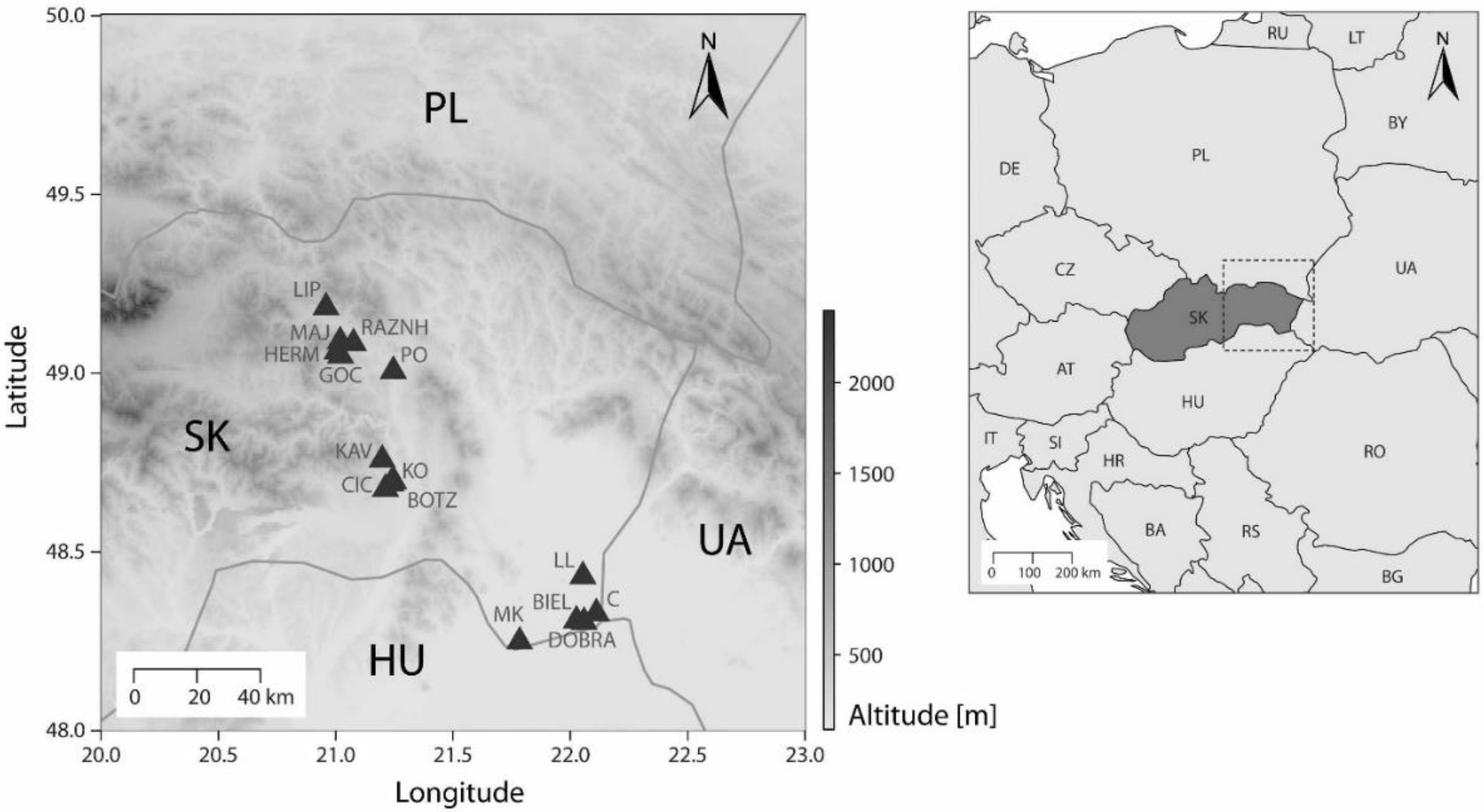
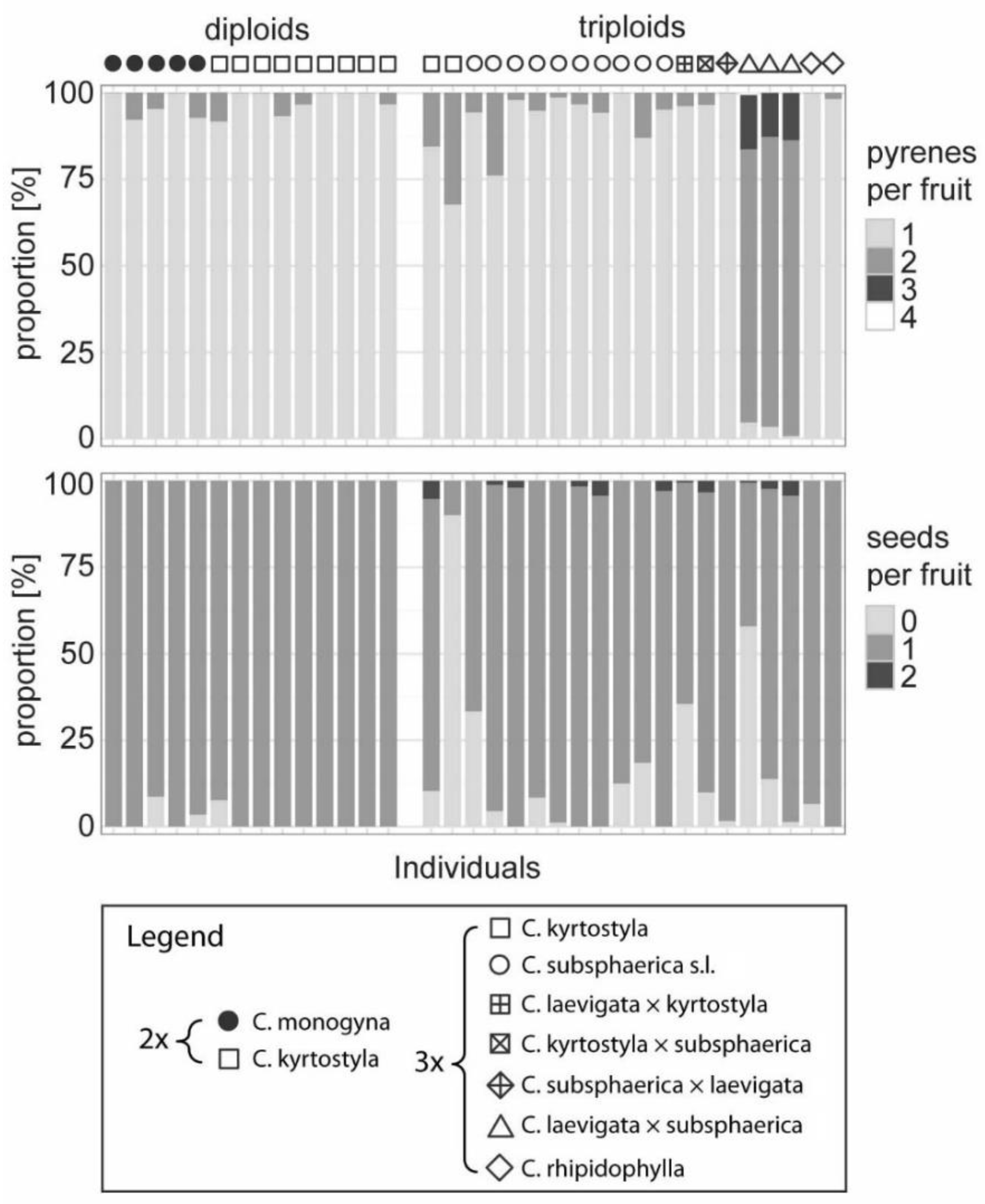
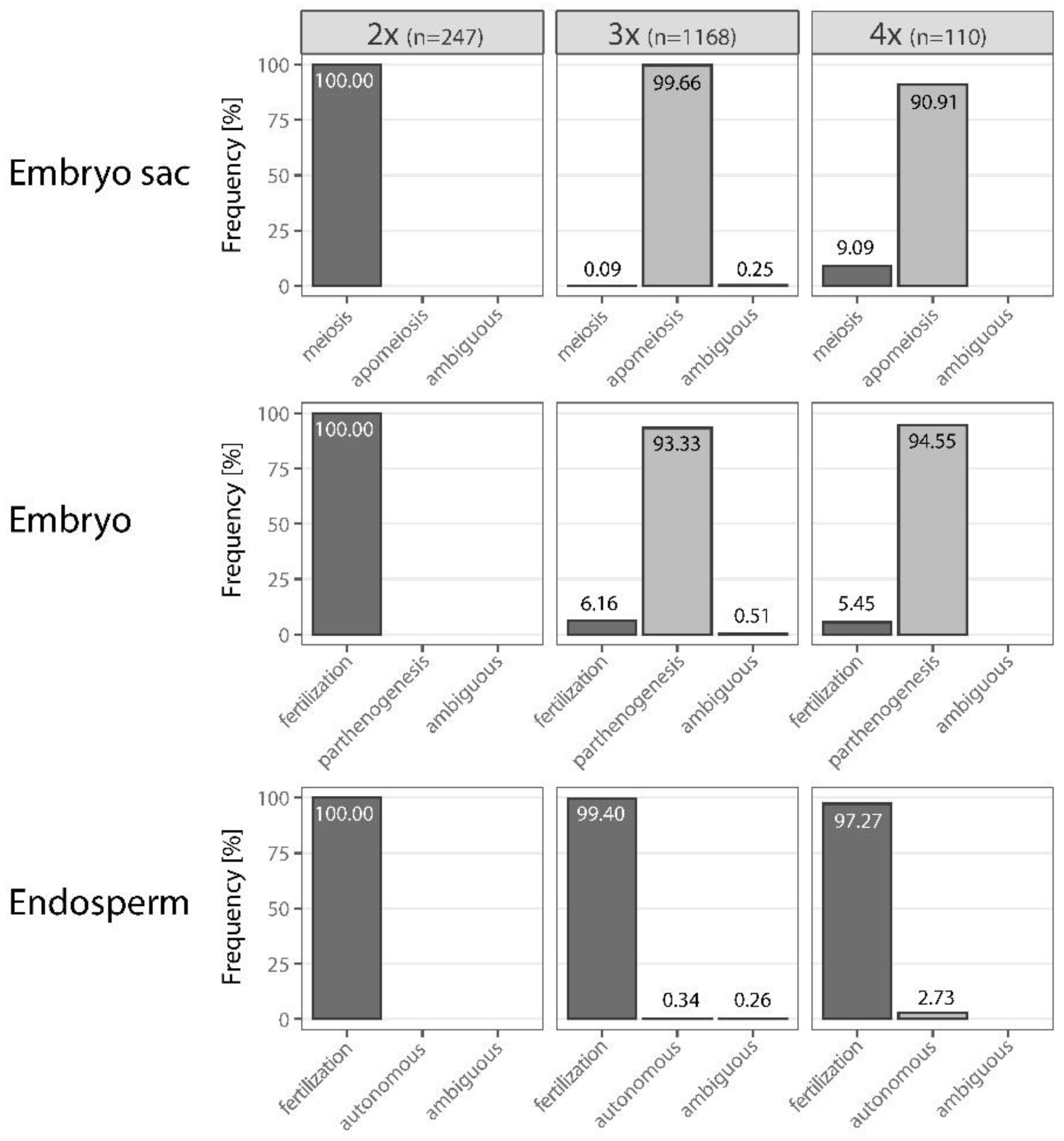
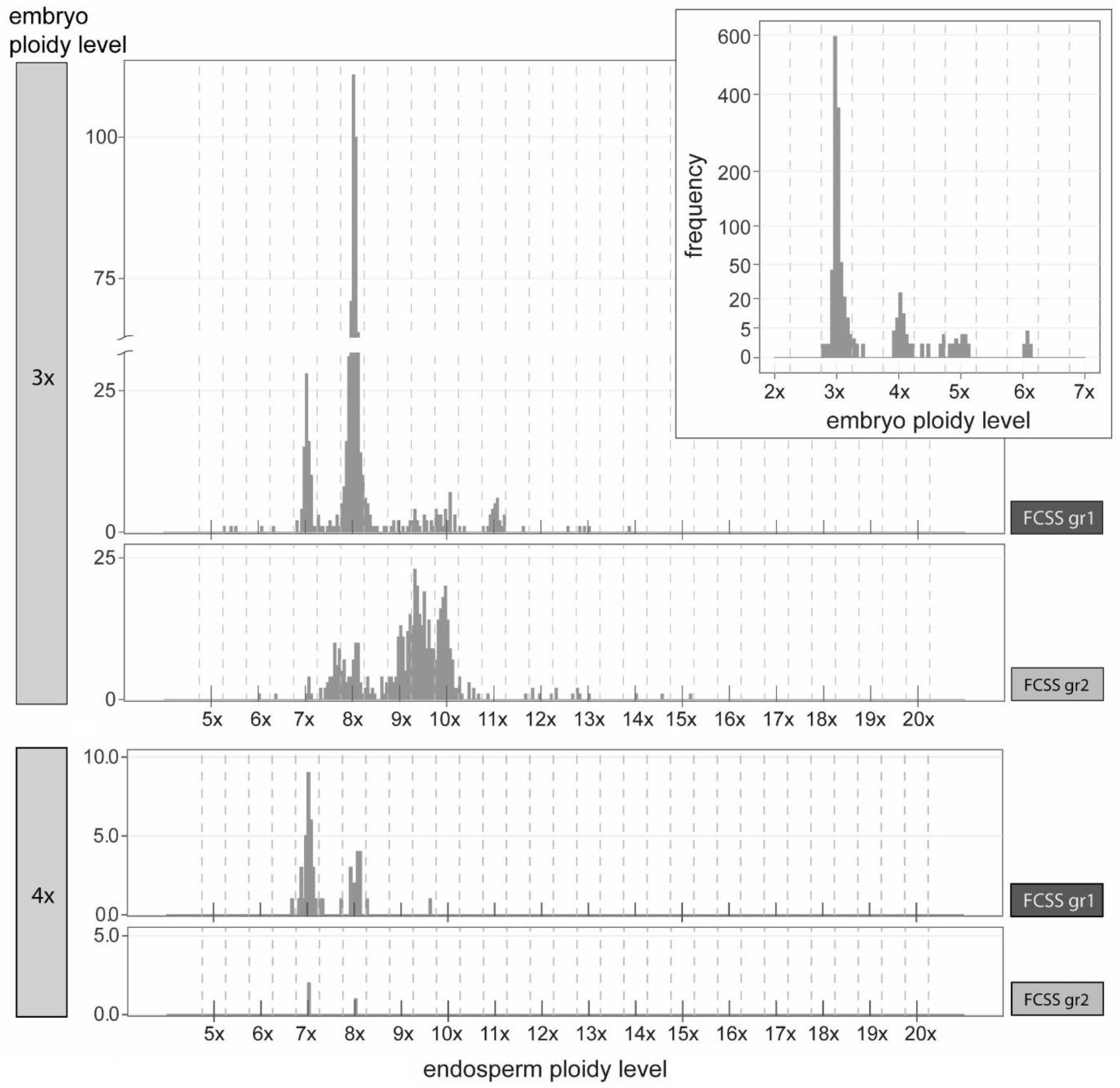
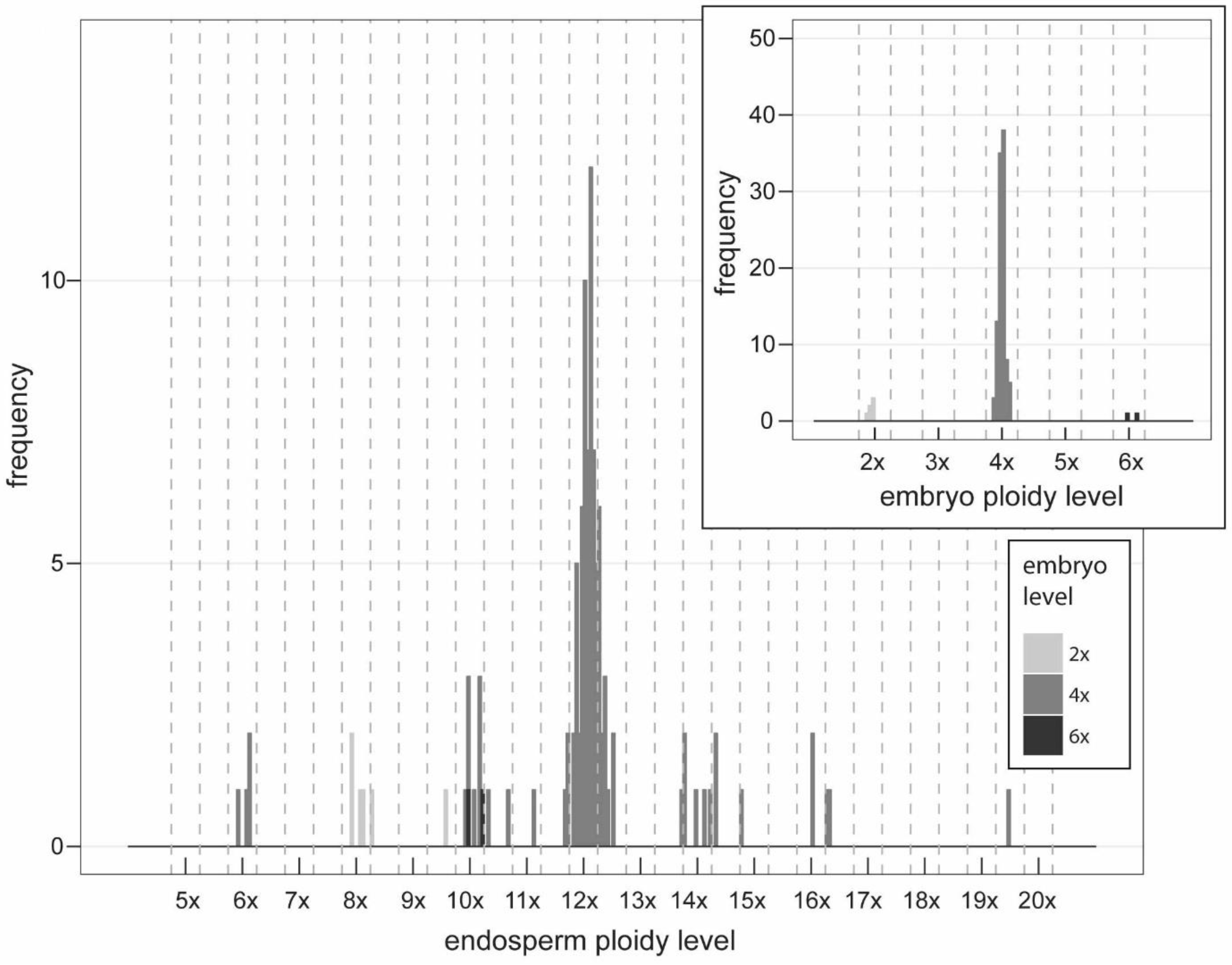
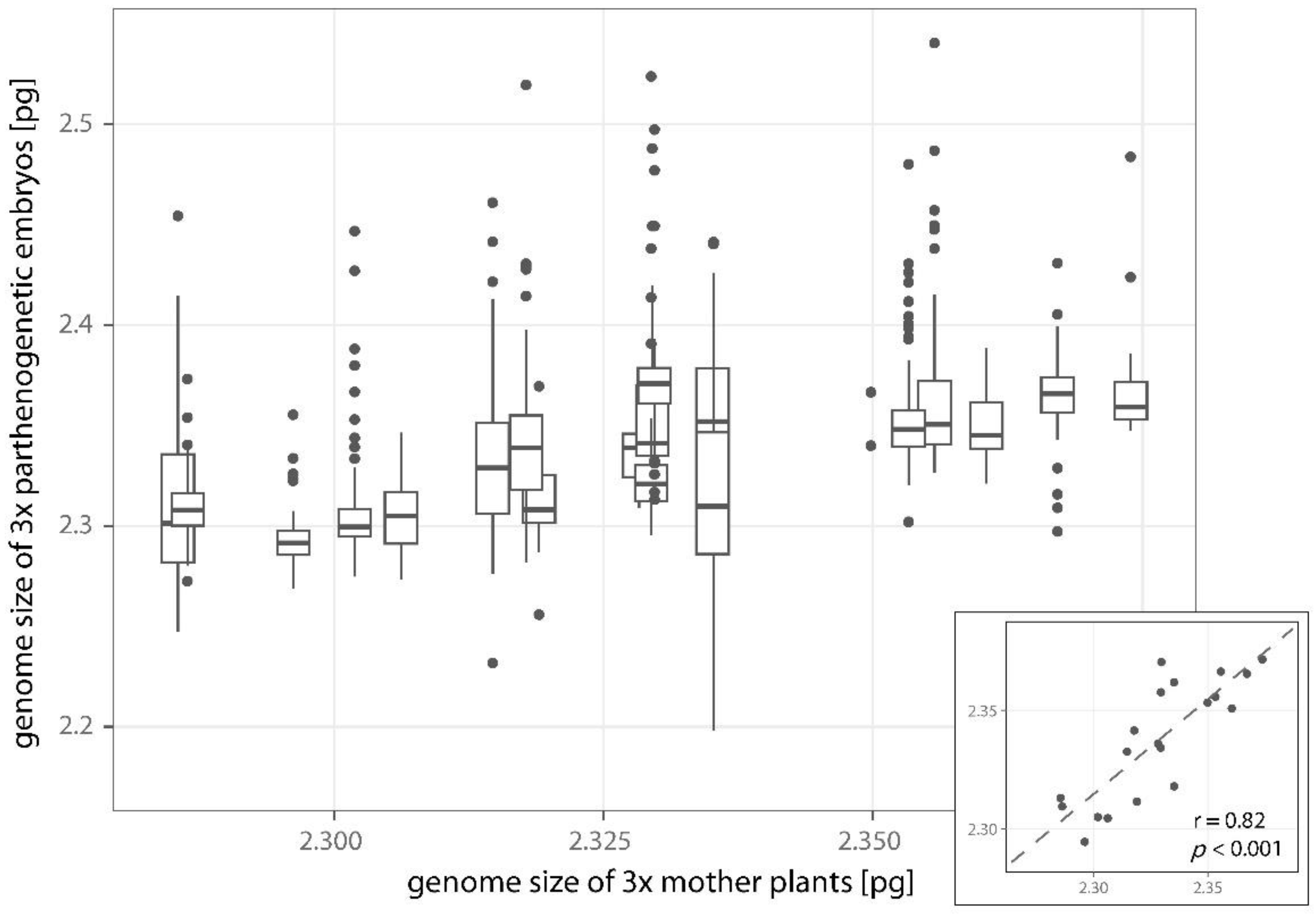
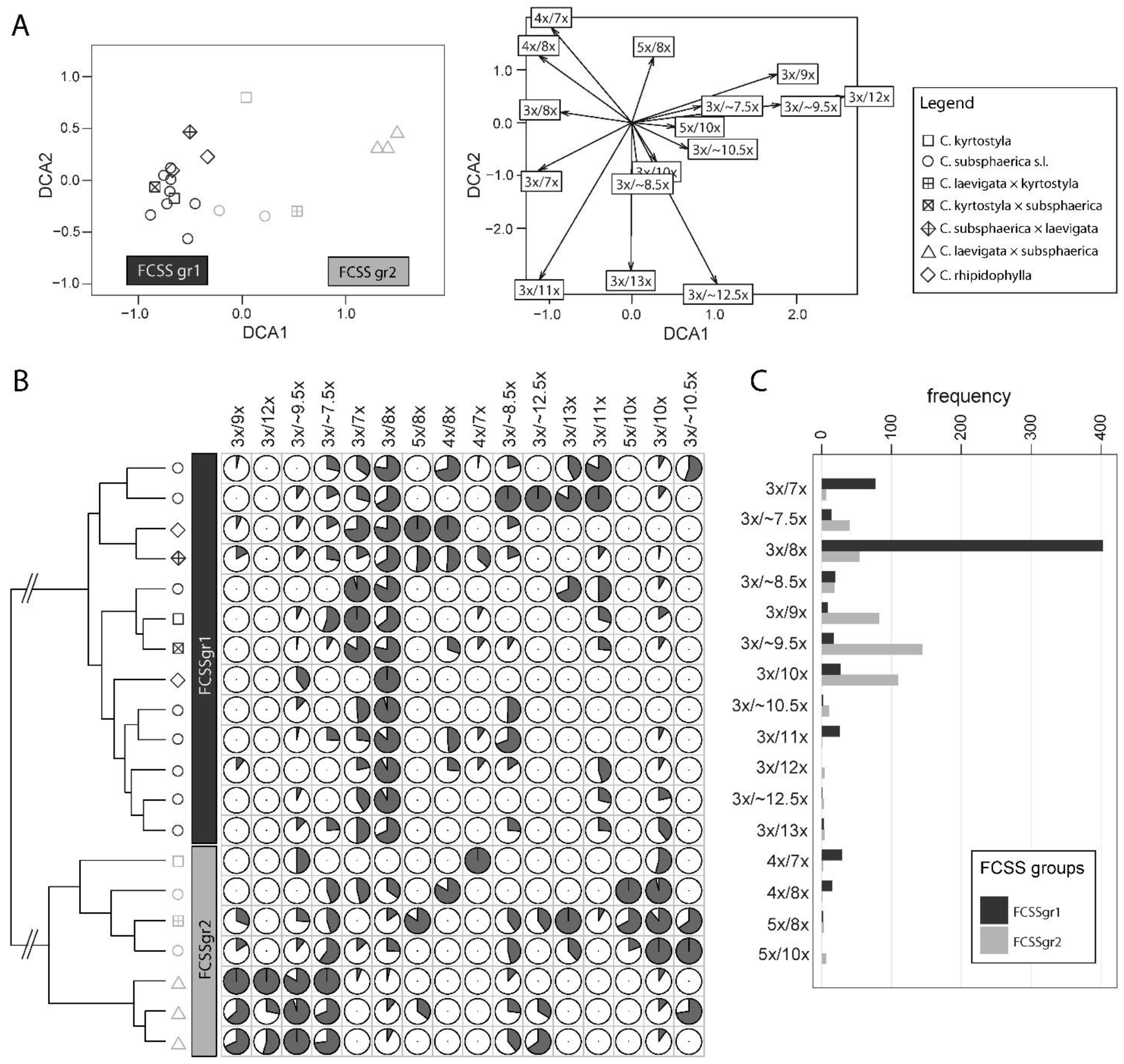
| Population | Code | Number of Plants | Proportion of Cytotypes [%] | ||
|---|---|---|---|---|---|
| 2x | 3x | 4x | |||
| Hermanovce * | HERM | 47 | 0.00 | 34.04 | 65.96 |
| Lipany | LIP | 40 | 100.00 | 0.00 | 0.00 |
| Košice, Čičky * | CIC | 28 | 35.71 | 46.43 | 17.86 |
| Čierna nad Tisou | C | 18 | 100.00 | 0.00 | 0.00 |
| Malý Kamenec | MK | 18 | 77.78 | 22.22 | 0.00 |
| Leles | LL | 11 | 90.91 | 9.09 | 0.00 |
| Hermanovce, Gočalka | GOC | 10 | 30.00 | 20.00 | 50.00 |
| Košice, Botanical Garden | BOTZ | 9 | 88.89 | 11.11 | 0.00 |
| Ražňany * | RAZNH | 9 | 33.33 | 22.22 | 44.44 |
| Košice, Kavečany * | KAV | 8 | 12.50 | 25.00 | 62.50 |
| Biel | BIEL | 7 | 100.00 | 0.00 | 0.00 |
| Uzovské Pekľany | MAJ | 2 | 0.00 | 0.00 | 100.00 |
| Dobrá | DOBRA | 1 | 100.00 | 0.00 | 0.00 |
| Prešov | PO | 1 | 100.00 | 0.00 | 0.00 |
| Košice, UVL | KO | 1 | 100.00 | 0.00 | 0.00 |
| SUM | 15 | 210 | |||
| Taxon | Ploidy Level | Locality | Plant Code | Fruits | FCSS Seeds | FCSS Success |
|---|---|---|---|---|---|---|
| C. monogyna | 2x | MK | MKT | 22 | 10 | 10 |
| 2x | CIC | MONOG1 | 29 | 20 | 18 | |
| 2x | CIC | MONOG3 | 28 | 20 | 20 | |
| 2x | CIC | KVP4 | 26 | 20 | 20 | |
| 2x | BOTZ | BOTZ1 | 23 | 20 | 20 | |
| 2x | BOTZ | BOTZ2 | NA | 10 | 10 | |
| 2x | KO | KO VETER | NA | 10 | 10 | |
| 2x | BIEL | BIEL15-3 | NA | 10 | 10 | |
| 2x | DOBRA | DOBRA1 | NA | 10 | 10 | |
| 2x | C | CIERNANT1 | NA | 10 | 7 | |
| C. kyrtostyla | 2x | PO | PO1 | 31 | 20 | 18 |
| 2x | CIC | KVP1 | 33 | 10 | 10 | |
| 2x | GOC | GOCAL15-1 | 12 | 10 | 10 | |
| 2x | GOC | GOCAL15-2 | 14 | 10 | 9 | |
| 2x | GOC | GOCAL15-3 | 11 | 10 | 10 | |
| 2x | LIP | LIP15-1 | 32 | 20 | 20 | |
| 2x | LIP | LIP15-2 | 28 | 20 | 20 | |
| 2x | LIP | LIP15-5 | 15 | NA | NA | |
| 2x | RAZNH | RAZNH15-1 | 15 | 10 | 10 | |
| 2x | RAZNH | RAZNH15-2 | NA | 8 | 5 | |
| Diploids SUM | 20 | 319 | 258 | 247 | ||
| C. kyrtostyla | 3x | CIC | 1518/11 | 58 | 29 | 29 |
| 3x | KAV | kyrtoA | 121 | 5 | 5 | |
| C. rhipidophylla | 3x | CIC | 1447/11 | 76 | 5 | 5 |
| 3x | CIC | 1453/11 | 58 | 47 | 46 | |
| C. subsphaerica | 3x | HERM | Vyhon3 | 198 | 98 | 97 |
| 3x | CIC | 1445/11 | 88 | 18 | 18 | |
| 3x | CIC | 1472/11 | 103 | 61 | 59 | |
| 3x | CIC | 1478/11 | 59 | 44 | 44 | |
| 3x | CIC | 1531/11 | 80 | 34 | 34 | |
| 3x | CIC | 1537/11 | 62 | 54 | 52 | |
| 3x | CIC | 1539/11 | 70 | 65 | 63 | |
| 3x | CIC | 1521/11 | 32 | 20 | 19 | |
| 3x | CIC | 1525/11 | 54 | 31 | 31 | |
| 3x | CIC | 1527/11 | 105 | 88 | 88 | |
| C. laevigata × C. kyrtostyla | 3x | HERM | Hurka1 | 239 | 114 | 110 |
| C. kyrtostyla × C. subsphaerica | 3x | RAZNH | RaznH2 | 121 | 104 | 100 |
| C. subsphaerica × C. laevigata | 3x | RAZNH | RaznH1 | 117 | 100 | 95 |
| C. laevigata × C. subsphaerica | 3x | HERM | Sosen3 | 140 | 135 | 133 |
| 3x | HERM | Vyhon4 | 215 | 73 | 67 | |
| 3x | HERM | Vyhon8 | 87 | 77 | 73 | |
| Triploids SUM | 20 | 2083 | 1202 | 1168 | ||
| C. subsphaerica | 4x | HERM | PS-Vyh16-1 | NA | 5 | 5 |
| 4x | HERM | PS-Vyh16-2 | NA | 8 | 7 | |
| 4x | HERM | Vyhon2 | NA | 8 | 8 | |
| 4x * | HERM | Vyhon16-16 | NA | 10 | 10 | |
| 4x | HERM | Vyhon16-15 | NA | 17 | 16 | |
| 4x * | RAZNH | RaznH16-3 | NA | 15 | 15 | |
| 4x | MAJ | MAJ16-1 | NA | 27 | 27 | |
| 4x | MAJ | MAJ16-2 | NA | 24 | 22 | |
| Tetraploids SUM | 8 | NA | 114 | 110 | ||
| Total SUM | 48 | 2402 | 1574 | 1525 |
| Maternal Plant Ploidy | Seed Category | ||||
|---|---|---|---|---|---|
| 2x | 2xemb/3xend (240; 97.17%) S/  | 3xemb/4xend (5; 2.02%) S/  *a *a | 2xemb/6xend (2; 0.81%) S/  ep ep | ||
| 3x | 3xemb/8xend (457; 38.13%) P/  + +  or or  | 3xemb/~8.5x–9x–~9.5xend *b (289; 24.74%) P/  + +  | 3xemb/10xend (136; 11.64%) P/  + +  | ||
| 3xemb/7xend (83; 7.11%) P/  | 3xemb/~7.5xend (54; 4.62%) P/  | 3xemb/6x–~6.5xend (4; 0.34%) P/aute | |||
| 3xemb/~>10xend *c (61; 5.22%) P/ep or pn | ~3.5xemb/9x–12xend *d (3; 0.26%) | ||||
| 4xemb/7xend (31; 2.65%) S(BIII)/  | 4–~4.5xemb/~6.5x–~7.5xend (9; 0.77%) S(BIII)/  or or  | 5xemb/8xend (5; 0.43%) S(BIII)/  | |||
| 4x, 5xemb/8x, 10xend (27; 2.31%) S(BIII)/  or or  , poly , poly | 6xemb/~≥14xend (6; 0.51%) P/ep | ||||
| 4x | 4xemb/12xend (56; 50.91%) P/  + +  | 4xemb/~11.5x, ~12.5xend *e (17; 15.45%) P/  + +  | 4xemb/10x–~10.5xend *f (9; 8.18%) P/  | ||
| 4xemb/~>12.5xend *c (14; 12.73%) P/  + +  or oraute + ep or pn? | 4xemb/~10.5x–11xend *g (2; 1.82%) P/  + +  | 2xemb/8x–~9.5xend *h (6; 5.45%) rP/  + +  or oraute + ep or pn? | |||
| 4xemb/6xend (4; 3.64%) S/  | 6xemb/10xend (2; 1.82%) S(BIII)/  | ||||
Publisher’s Note: MDPI stays neutral with regard to jurisdictional claims in published maps and institutional affiliations. |
© 2022 by the authors. Licensee MDPI, Basel, Switzerland. This article is an open access article distributed under the terms and conditions of the Creative Commons Attribution (CC BY) license (https://creativecommons.org/licenses/by/4.0/).
Share and Cite
Kolarčik, V.; Kocová, V.; Mikoláš, V.; Mártonfiová, L.; Hajdučeková, N.; Mártonfi, P. Variability of Reproduction Pathways in the Central-European Populations of Hawthorns with Emphasis on Triploids. Plants 2022, 11, 3497. https://doi.org/10.3390/plants11243497
Kolarčik V, Kocová V, Mikoláš V, Mártonfiová L, Hajdučeková N, Mártonfi P. Variability of Reproduction Pathways in the Central-European Populations of Hawthorns with Emphasis on Triploids. Plants. 2022; 11(24):3497. https://doi.org/10.3390/plants11243497
Chicago/Turabian StyleKolarčik, Vladislav, Valéria Kocová, Vlastimil Mikoláš, Lenka Mártonfiová, Nikola Hajdučeková, and Pavol Mártonfi. 2022. "Variability of Reproduction Pathways in the Central-European Populations of Hawthorns with Emphasis on Triploids" Plants 11, no. 24: 3497. https://doi.org/10.3390/plants11243497
APA StyleKolarčik, V., Kocová, V., Mikoláš, V., Mártonfiová, L., Hajdučeková, N., & Mártonfi, P. (2022). Variability of Reproduction Pathways in the Central-European Populations of Hawthorns with Emphasis on Triploids. Plants, 11(24), 3497. https://doi.org/10.3390/plants11243497







